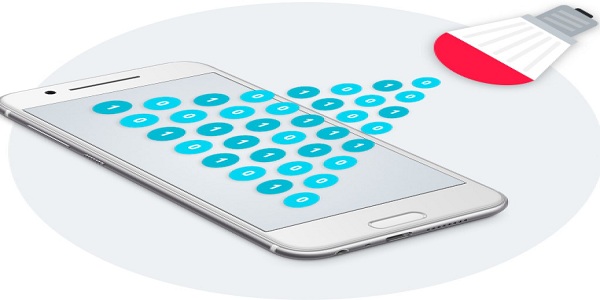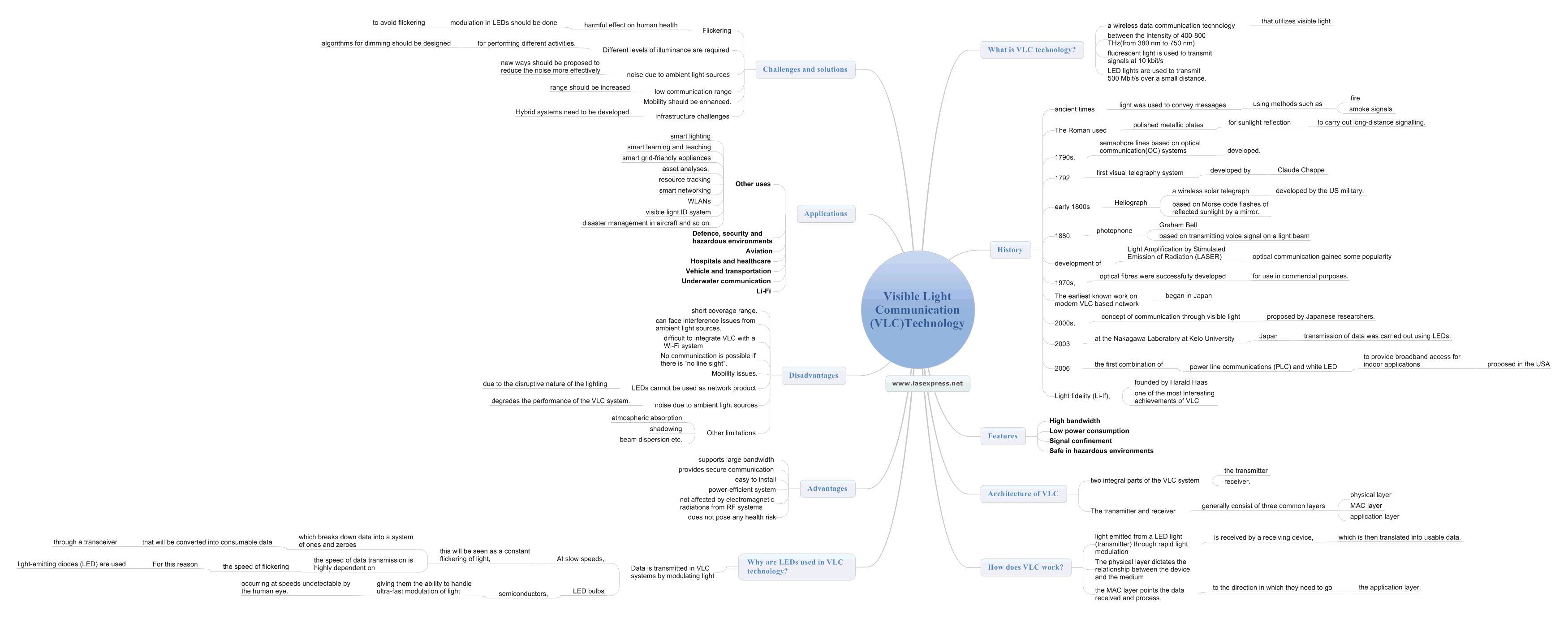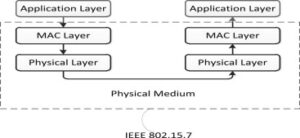Visible Light Communication (VLC) Technology – All You Need To Know

From Current Affairs Notes for UPSC » Editorials & In-depths » This topic
IAS EXPRESS Vs UPSC Prelims 2024: 85+ questions reflected
According to the latest forecasts, mobile data traffic is expected to grow at a compounded rate annually in the coming years. Considering the high-congested nature of the radio spectrum, its high latency issues and the interferences it suffers, a complementary solution is required and Visible Light Communication(VLC) Technology is one of the leading candidates to provide the solution. Visible Light Communication(VLC) Technology is an emerging technology. It intends to enable high-speed internet access primarily in the indoor environment. VLC technology has several advantages over traditional radio-frequency(RF) based networks. The objective of VLC is to increase data rates in wireless communication and to have better performance of networks, especially for indoor networks.
What is VLC technology?
It is a wireless data communication technology that utilizes visible light between the intensity of 400-800 THz(from 380 nm to 750 nm) to communicate. Under this technology, fluorescent light is used to transmit signals at 10 kbit/s and LED lights are used to transmit 500 Mbit/s over a small distance.
History
- In ancient times, light was used to convey messages using methods such as fire and smoke signals.
- The Roman used polished metallic plates for sunlight reflection to carry out long-distance signalling.
- In the 1790s, semaphore lines based on optical communication(OC) systems were developed.
- The first visual telegraphy system was developed by Claude Chappe in 1792 in France.
- In the early 1800s, Heliograph, a wireless solar telegraph was developed by the US military. It was based on Morse code flashes of reflected sunlight by a mirror.
- In 1880, Graham Bell introduced his photophone that was based on transmitting voice signal on a light beam. It was revolutionary as it was the first to utilize modulated light for communication.
- It was by the development of Light Amplification by Stimulated Emission of Radiation (LASER) that optical communication gained some popularity.
- In the 1970s, optical fibres were successfully developed for use in commercial purposes.
- The earliest known work on modern VLC based network began in Japan. The research focused on transmitting data by visible light through the use of light-emitting diodes (LEDs).
- In the 2000s, the concept of communication through visible light was proposed by Japanese researchers.
- In 2003, at the Nakagawa Laboratory at Keio University, Japan, the transmission of data was carried out using LEDs.
- In 2006, the first combination of power line communications (PLC) and white LED to provide broadband access for indoor applications was proposed in the USA.
- Light fidelity (Li-Fi), founded by Harald Haas is one of the most interesting achievements of VLC for several years.
Features
- High bandwidth – It can transmit a large amount of data in a short time.
- Low power consumption – It consumes low power and emits low energy.
- Signal confinement – As light cannot pass through opaque walls, it is easy to confine the signals in form of light in a single room which helps in the increased security of the network.
- Safe in hazardous environments – In those environments where radio-frequencies are considered hazardous like aeroplanes, hospitals, mines, etc., VLC technology is a perfect alternative.
Architecture of VLC
There are two integral parts of the VLC system. These are – the transmitter and receiver. The transmitter and receiver generally consist of three common layers. These are the physical layer, MAC layer and application layer.
How does VLC work?
In VLC, light emitted from a LED light (transmitter) through rapid light modulation is received by a receiving device, which is then translated into usable data. The physical layer dictates the relationship between the device and the medium, the MAC layer points the data received and process to the direction in which they need to go – the application layer.
Why are LEDs used in VLC technology?
Data is transmitted in VLC systems by modulating light. At slow speeds, this will be seen as a constant flickering of light, which breaks down data into a system of ones and zeroes that will be converted into consumable data through a transceiver. However, the speed of data transmission is highly dependent on the speed of flickering. For this reason, light-emitting diodes (LED) are used as the primary light source in VLC systems. LED bulbs are semiconductors, giving them the ability to handle ultra-fast modulation of light occurring at speeds undetectable by the human eye.
Advantages
- It supports large bandwidth and thus can overcome the bandwidth limitation of RF communication.
- It provides secure communication as data transmission cannot be interrupted by people staying at some other place which is a problem in RF communication.
- It is easy to install.
- VLC source can be used both for illumination and communication and consumes low power. Thus, it is a power-efficient system.
- As it is a light-based communication system, it is not affected by electromagnetic radiations from RF systems.
- It does not pose any health risk.
Disadvantages
- VLC technology has a short coverage range.
- This technology can face interference issues from ambient light sources.
- It is difficult to integrate VLC with a Wi-Fi system.
- No communication is possible if there is “no line sight”.
- Mobility issues.
- LEDs cannot be used as network product due to the disruptive nature of the lighting.
- The noise due to ambient light sources degrades the performance of the VLC system.
- Other limitations include atmospheric absorption, shadowing, beam dispersion etc.
Applications
- Li-Fi – Li-Fi is a high speed bi-directional fully connected, visible-light wireless communication system similar to Wi-Fi. Li-Fi uses visible light for communication whereas Wi-fi uses radio-frequency for communication. It also supports the Internet of Things(IoT).
- Vehicle and transportation – It can also be used in vehicular communication due to the presence of the vehicle lights and the existing traffic light infrastructure. This may include cooperative forward collision warning, pre-crash sensing, emergency electronic brake lights, lane change warning, stop sign movement assistant, left turn assistant, traffic signal violation warning and curve speed warning It also allows inter-vehicle communication by using the front lights as transmitter and the back red light as a receiver and thus can prevent accidents.
- Underwater communication – It can also be used for underwater communication as radio frequencies do not travel well in seawater because of its good conductivity.
- Hospitals and healthcare – It can also be used in hospitals as hospitals have electromagnetic wave sensitive areas (such as MRI scanners and operation theatres). VLC can be advantageous in these places because this spectrum does not interfere with the RF spectrum.
- Aviation – It can be used in aircraft cabins to reduce electromagnetic interference. It can also be used to provide air passengers with continuous communication services.
- Defence, security and hazardous environments – As VLC signals cannot pass through walls, they are well-suited for security-related usage. The VLC technology is also safe for usage in a mining environment and petrochemical plant.
- Other uses – These include smart lighting, smart learning and teaching, smart grid-friendly appliances, asset analyses, resource tracking, smart networking, wireless local area networks (WLANs), visible light ID system, disaster management in aircraft and so on.
Challenges and solutions
- Flickering is often noticed in LEDs. This harms human health. Therefore, the modulation in LEDs should be done in a way to avoid flickering.
- Different levels of illuminance are required for performing different activities. Therefore, the algorithms for dimming should be designed so that the required illuminance in a particular place is fulfilled.
- The noise due to ambient light sources degrades the performance. So, new ways should be proposed to reduce the noise more effectively than the previously used techniques.
- As it has a low communication range, the range should be increased.
- Mobility should be enhanced.
- Infrastructure challenges as it is difficult to integrate with existing wireless networks. Hybrid systems need to be developed to counter this problem.
Way forward
With the RF limitations in place, VLC technology must be given due importance. There are numerous challenges that the technology faces in its practical implementation which need to be addressed. VLC technology shows bright prospects in the future 4G or 5G wireless access networks due to its inherent advantages. Standard regulations are also needed to regulate this technology and its use. Further research in this area can prove to be worthwhile.
Practise Question
- Write a note on the emerging VLC technology, how does it work and mention the challenges in its practical implementation.
If you like this post, please share your feedback in the comments section below so that we will upload more posts like this.



